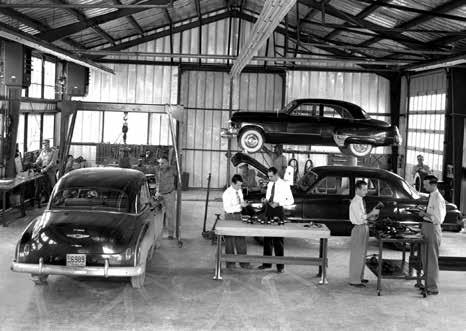
2 minute read
SwRI Deploys Automated Shuttle
As a leader in software and systems integration development for automated vehicles and robotics, SwRI has deployed an automated shuttle at its 1,500-acre campus.
Capable of ferrying up to 14 passengers, the shuttle uses algorithms, sensors, cameras and software that SwRI developed through internal research into automated driving. During operations, a human driver sits behind a steering wheel as an additional safety measure.
“It is rewarding for our engineers to take the very best technology that SwRI has developed to serve our clients and then embed it into a showcase vehicle that has a practical purpose in our backyard,” said Ryan Lamm, director of SwRI’s Applied Sensing Department.
Using SwRI’s Ranger system, the vehicle autonomously drives unique routes around the grounds. Ranger is a localization tool that uses a ground-facing camera and automation software to precisely maintain its position to within two centimeters on a given route.
“Fully automated driverless vehicles are still several years away, but this shuttle proves that we are well on our way to such a future,” said Dr. Steve Dellenback, vice president of SwRI’s Intelligent Systems Division.
The shuttle’s core functionality lies in SwRI’s autonomy stack, a suite of tools utilizing proprietary machine learning algorithms, software and processing tools as well as cameras and sensors. SwRI has been developing the shuttle technology for over a year.
Classified as a low-speed vehicle (LSV) operating at less than 50 mph, the shuttle is ideal for closed campuses, such as the SwRI headquarters, or roads with lower speed limits. The Ranger system creates maps of the unique characteristics of the asphalt and recognizes features such as intersections, lanes and crosswalks. The operator can select from various mapped routes.
It uses sensor systems and artificial intelligence to classify roadway signs, pedestrians, vehicles and other objects. SwRI has programmed the shuttle for various driving scenarios such as sharing the road with other vehicles, detecting dynamic objects such as cyclists, and determining right of way at intersections.
“The shuttle collects data every time it is on the road, allowing us to continually refine its algorithms to improve reactions in various situations,” said Alexander Youngs, an SwRI senior research engineer who led development of the shuttle.
Additional capabilities include the ability to integrate and share data with intelligent transportation systems and other connected and automated vehicles. The shuttle can be deployed in a convoy of similar vehicles, taking traffic and congestion into consideration for improved mobility.
“This mid-size passenger vehicle presents future opportunities to improve mobility and access to transportation in neighborhoods where large buses cannot travel,” said SwRI’s Dan Rossiter. “We are thrilled to be able to say San Antonio not only has this capability at SwRI, but that we are helping to develop and deploy similar systems around the globe.”
The shuttle is a working research platform, allowing SwRI to create and upgrade the vehicle with new automation capabilities and innovations. In addition to serving as a functional tour shuttle, it continues to serve as a test bed for other pilot programs for government and industry clients seeking to deploy similar shuttles on both closed campuses and open roads.
Watch a video of the shuttle at https:/youtu.be/hoCwBnqQSx0.
Alex Youngs demonstrates the self-driving capability of the SwRI automated shuttle, a 14-passenter, self-driving transport vehicle equipped with lidar, camera sensors and machine vision algorithms that enable automated driving. The shuttle autonomously navigates campus tours on pre-programmed routes, but a human driver is always behind the steering wheel for added safety.
D025615










